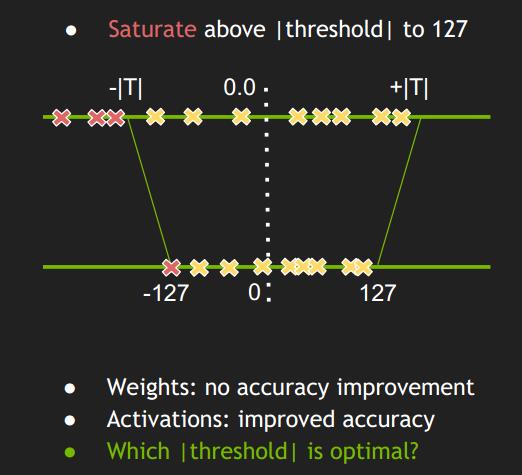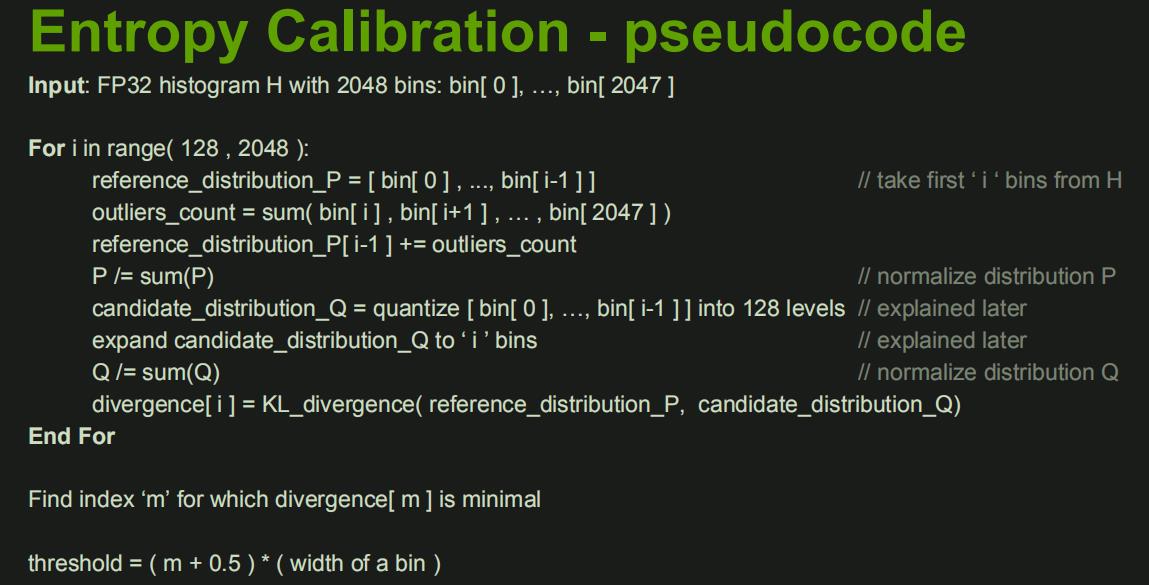模型推理量化实现分享二:详解 KL 对称量化算法实现
Posted 极智视界
tags:
篇首语:本文由小常识网(cha138.com)小编为大家整理,主要介绍了模型推理量化实现分享二:详解 KL 对称量化算法实现相关的知识,希望对你有一定的参考价值。
欢迎关注我的公众号 [极智视界],回复001获取Google编程规范
O_o >_< o_O O_o ~_~ o_O
大家好,我是极智视界,本文剖析一下 KL 对称量化算法实现,以 Tengine 的实现为例。
前面已经写过一篇《【模型推理】量化实现分享一:详解 min-max 对称量化算法实现》,有兴趣的同学可以查阅。这是上一篇的续集,也是量化实现详解的第二篇。
量化背景就不多做介绍了,之前的文章中也说的比较多了,直接开始吧。
1、KL 量化原理
KL 量化是用 KL 散度来衡量真实数据分布和量化数据分布之间的相似性的量化方法,是英伟达 TensorRT 中对于激活值采用的量化策略,KL 量化的主要逻辑如下:

- KL 和 MIN-MAX 不一样,不是直接将
[min, max]映射到[-127, 127],而是去寻找一个阈值|T| < max(|max|, |min|),将其[-T, T]映射到[-127, 127]。认为只要阈值选取得当,就能将阈值以外的值舍弃掉,也不会对精度损失造成大的影响; - 超出阈值
±|T|以外的值直接映射为阈值,如上图中的三个红色点,直接映射为 -127,这种映射关系称为是饱和的。
KL 量化方法试图将 float32 数值分布和 int8 数值分布抽象成两个分布,用阈值 |T| 来更新这两个数值分布,并用 KL 散度来衡量这两个分布的相似性,若 KL 散度值越小,说明这两个分布越相似,也就说明这个阈值 |T| 选择的最好。对于对称量化来说,根据这个阈值就能算出 Scale,而 Zero_point 始终为零。
下面的图是 TensorRT 中的关于 KL 散度校准的伪代码,这个图也完美诠释了 KLD 整个量化过程。(标记一下下图为图二,后面会调用)

2、KL 量化实现
这里还是以 Tengine 中 KL 量化的实现进行说明。
捋一下主要有以下几个流程:
(1) 激活值量化:先求 min、max,再用 KL 策略搜索量化生成激活值校准表。fp32toint8;
(2) 权值量化:使用 min-max 量化策略。fp32toint8;
(3) 偏置量化:延用激活值量化 scale 进行 int32 量化。fp32toint32;
权值和偏置的量化比激活值量化多一步,除了要计算 Scale 外,还需要对值应用 Scale 进行直接量化以生成 int8 tmfile。
在 Tengine 中实现 KL 量化的主要代码如下:
case ALGORITHM_KL:
if (quant_tool.scale_file.empty())
quant_tool.scale_file = "table_kl.scale";
quant_tool.activation_quant_tool();
save_graph_i8_perchannel(quant_tool.model_file.c_str(), quant_tool.scale_file.c_str(), quant_tool.output_file, quant_tool.inplace, false);
/* Evaluate quantitative losses */
if (quant_tool.evaluate)
fprintf(stderr, "[Quant Tools Info]: Step Evaluate, evaluate quantitative losses\\n");
quant_tool.assess_quant_loss(0);
break;
其中最主要的量化搜索策略接口是 quant_tool.activation_quant_tool() 和 save_graph_i8_perchannel,对于 KL 量化来说这两个接口分别做了两件事:
(1) 激活值量化,生成 table_kl.scale;
(2) 权值&偏置量化,生成 scale_weight.txt、scale_bias.txt 和 int8 tmfile;
由于激活值量化中的 min、max 计算方式 及 权值&偏置量化过程,KL 量化和 MIN-MAX 量化逻辑相同且共用相同代码,这里就不展开介绍了,这部分有兴趣的同学可以查阅 《【模型推理】量化实现分享一:详解 min-max 对称量化算法实现》,这里主要介绍激活值量化中的 KL 量化搜索策略。
KL 量化搜索策略的入口在这:
quant_tool.activation_quant_tool();
然后会先做 min、max 的比较搜索,主要用了 std::max_element、std::min_element 接口,这里不多说,得到 min、max 值后开启 KL 搜索策略。
2.1 勾勒概率直方图
做第一轮勾勒概率直方图,进行第一轮的 KL 计算,第二轮开始不用重新勾勒概率直方图,而是在第一轮构建的概率直方图上进行迭代,所以你的校准图片数量越多,这个最终得到的概率直方图会越逼近真实分布。
/* calculate hist */
uint32_t inum = 0;
for (int i = 0; i < ir_graph->tensor_num; i++)
struct tensor* ir_tensor = ir_graph->tensor_list[i];
if (ir_tensor->tensor_type == TENSOR_TYPE_VAR || ir_tensor->tensor_type == TENSOR_TYPE_INPUT)
float step_max = std::abs(max_activation[i]);
if (std::abs(min_activation[i]) > step_max)
step_max = std::abs(min_activation[i]);
float step_bin = step_max / 2048.0f;
std::vector<float> every_edge;
if (nums == imgs_list.size() - 1)
for (int j = 0; j < 2048; j++)
float edge_float = (step_bin * (j + 0.5f));
every_edge.push_back(edge_float);
hist_edge.push_back(every_edge);
hist_gram.push_back(histCount((float*)ir_tensor->data, ir_tensor->elem_num, step_max));
else
std::vector<uint32_t> hist_tmp;
hist_tmp = histCount((float*)ir_tensor->data, ir_tensor->elem_num, step_max);
for (int j = 0; j < 2048; j++)
hist_gram[inum][j] += hist_tmp[j];
tensor_hist[i] = inum;
hist_tensor[inum] = i;
inum++;
来看以下 histCount 接口:
std::vector<uint32_t> histCount(float* data, uint32_t elem_num, float abs_max)
float bin_scale = abs_max / 2047.f;
int bin_zp = 0;
std::vector<uint32_t> hist(2048);
for (int i = 0; i < elem_num; i++)
if (data[i] != 0)
uint32_t hist_idx = round(std::abs(data[i]) / bin_scale);
hist[hist_idx]++;
return hist;
最后对得到的概率直方图做一个归一化处理:
distribution = normalize_histogram(distribution_in);
直方图归一化的实现接口也很简单:
std::vector<float> normalize_histogram(std::vector<uint32_t>& histogram)
std::vector<float> histogram_out(histogram.size());
const size_t length = histogram.size();
float sum = 0;
for (size_t i = 1; i < length; i++)
sum += histogram[i];
for (size_t i = 1; i < length; i++)
histogram_out[i] = float(histogram[i] / sum);
return histogram_out;
2.2 计算 P
接下来的逻辑需要回头看一下图二,先计算 P 再计算 Q 最后计算 KL 散度。
先是计算模拟量化分布 P,从 target_bin = 128 --> 2048 递增检索,溢出部分映射到边缘处理,可以把 P 认为是量化前 fp32 数据分布,即真实分布:
// get P
fill(quantize_distribution.begin(), quantize_distribution.end(), 0.0f);
const float num_per_bin = static_cast<float>(threshold) / static_cast<float>(target_bin);
for (int i = 0; i < target_bin; i++)
const float start = static_cast<float>(i) * num_per_bin;
const float end = start + num_per_bin;
const int left_upper = static_cast<int>(ceil(start));
if (static_cast<float>(left_upper) > start)
const float left_scale = static_cast<float>(left_upper) - start;
quantize_distribution[i] += left_scale * distribution[left_upper - 1];
const int right_lower = static_cast<int>(floor(end));
if (static_cast<float>(right_lower) < end)
const float right_scale = end - static_cast<float>(right_lower);
quantize_distribution[i] += right_scale * distribution[right_lower];
for (int j = left_upper; j < right_lower; j++)
quantize_distribution[i] += distribution[j];
2.2 计算 Q
然后是计算真实量化分布 Q,伴随 P 从 target_bin = 128 --> 2048 递增检索,可以把 Q 认为是量化后 int8 数据分布,即量化分布:
// get Q
std::vector<float> expand_distribution(threshold, 0);
for (int i = 0; i < target_bin; i++)
const float start = static_cast<float>(i) * num_per_bin;
const float end = start + num_per_bin;
float count = 0;
const int left_upper = static_cast<int>(ceil(start));
float left_scale = 0;
if (static_cast<float>(left_upper) > start)
left_scale = static_cast<float>(left_upper) - start;
if (distribution[left_upper - 1] != 0)
count += left_scale;
const int right_lower = static_cast<int>(floor(end));
float right_scale = 0;
if (static_cast<float>(right_lower) < end)
right_scale = end - static_cast<float>(right_lower);
if (distribution[right_lower] != 0)
count += right_scale;
for (int j = left_upper; j < right_lower; j++)
if (distribution[j] != 0)
count++;
const float expand_value = quantize_distribution[i] / count;
if (static_cast<float>(left_upper) > start)
if (distribution[left_upper - 1] != 0)
expand_distribution[left_upper - 1] += expand_value * left_scale;
if (static_cast<float>(right_lower) < end)
if (distribution[right_lower] != 0)
expand_distribution[right_lower] += expand_value * right_scale;
for (int j = left_upper; j < right_lower; j++)
if (distribution[j] != 0)
expand_distribution[j] += expand_value;
2.3 计算 KL 散度
接下来是计算真实分布 P 和量化分布 Q 的 KL 散度:
const float kl_divergence = compute_kl_divergence(t_distribution, expand_distribution);
实现 KL 散度计算的接口也很简单:
float compute_kl_divergence(std::vector<float>& dist_a, std::vector<float>& dist_b)
const size_t length = dist_a.size();
float result = 0;
for (size_t i = 0; i < length; i++)
if (dist_a[i] != 0)
if (dist_b[i] == 0)
result += 1;
else
result += dist_a[i] * log(dist_a[i] / dist_b[i]);
return result;
最终我们是想找到一个使 KL 散度最小的 target_bin,由于是在 128 --> 2048 的循环中检索的,所以这个实现可以这么写:
// the best num of bin
if (kl_divergence < min_kl_divergence)
min_kl_divergence = kl_divergence;
target_threshold = threshold;
这样就得到了我们梦寐以求的那个 target_bin,也就是这里的 target_threshold。
2.4 计算 Scale
在计算得到 target_threshold 后,再去计算 Scale 就很简单了,直接这样就好了。
float act_scale = hist_edge[i][threshold_bin] / fake_quant_set; // fake_quant_set = 127
int act_zero_point = 0;
重申,由于是对称量化,所以只需计算 Scale,Zero_point 始终为零。
然后就可以保存我们的激活值量化校准表 table_kl.scale 了,再次重申,后面的权值&偏置量化方法和 MIN-MAX 的一致,而 MIN-MAX 的量化方法我在前面的文章中已经介绍过,这里就不多赘述。
以上就完成了实用的 KL 散度量化算法的实现,希望我的分享能对你的学习有一点帮助。
【公众号传送】
扫描下方二维码即可关注我的微信公众号【极智视界】,获取更多AI经验分享,让我们用极致+极客的心态来迎接AI !

以上是关于模型推理量化实现分享二:详解 KL 对称量化算法实现的主要内容,如果未能解决你的问题,请参考以下文章
模型推理量化实现分享一:详解 min-max 对称量化算法实现